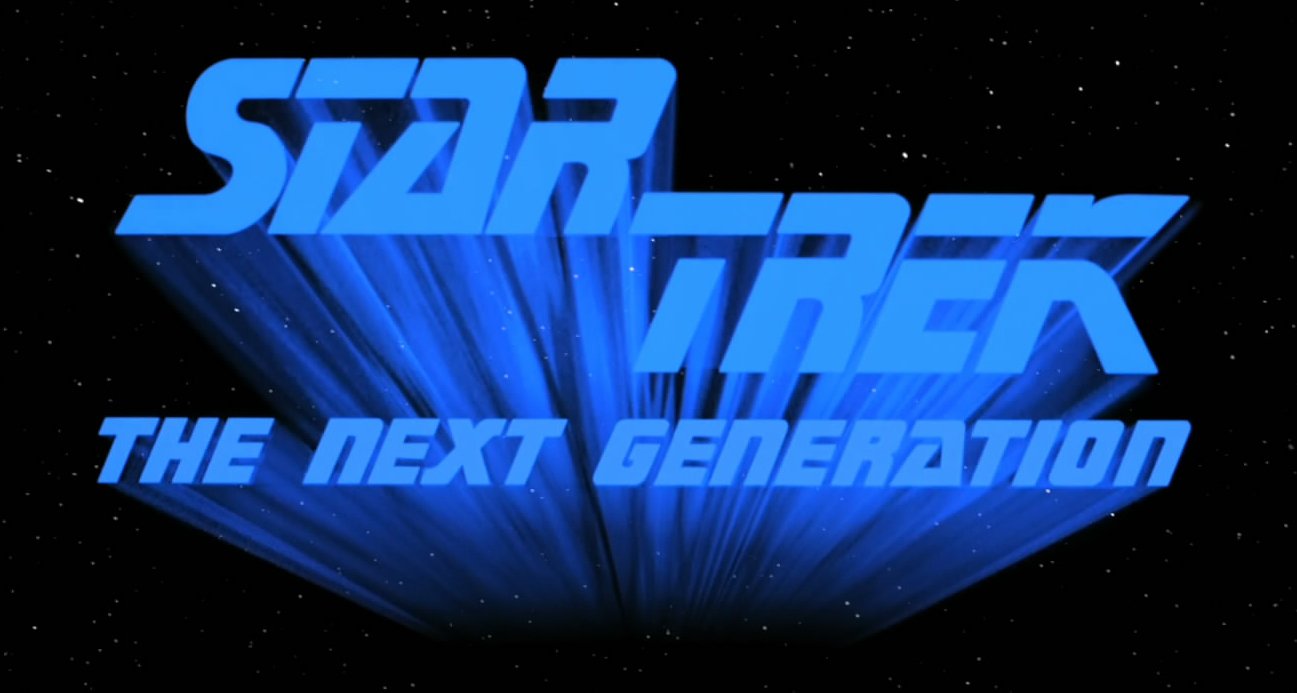
Hello and welcome as always to ‘Final Frontier Friday’! I’ve said before that this year I’m trying to expand the scope of the column, putting a bit more of a focus on shows like ‘Voyager’ and ‘Enterprise’ (and eventually, yes, ‘Discovery’), and I think I’m off to a good start on that front. But if you’ve been a regular reader for the last year or so, you know that there was no way I was going to stay away from ‘The Next Generation’ for long. So this week we’re digging into that show’s fourth season for our look at ‘The Drumhead’.
Let’s talk about clip shows! Networks and studios love them. They’re fairly cheap to produce, and it allows them to churn out that many more episodes per year. But everyone else kind of hates them. It’s common for producers to echo the attitude of ‘TNG’ executive producer Michael Piller, who once described them as “insulting to the audience.” And really, who among us hasn’t tuned in to our favorite show, only to feel cheated when we realized we were in for a glorified highlight reel? Thankfully, the proliferation of streaming services and the popularization of DVD box sets before that went a long way toward killing the practice once and for all.
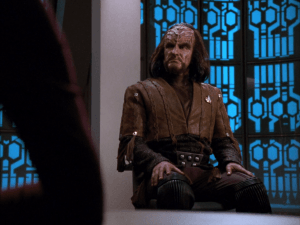 Of course, when work began on ‘The Drumhead’, clip shows were alive and well. In fact, ‘TNG’ had done one just two years earlier, with the execrable Season Two ender ‘Shades of Gray’. Well, by this point, late in the fourth season, the budget was getting tight. As a solution, the studio began pushing for another clip show. Though the producers were thankfully able to dissuade the studio from insisting on a clip show, instead settling on a similarly budget-friendly courtroom drama approach, you can nonetheless see evidence of this origin in the finished episode, mainly in its extensive references to prior installments, including ‘Conspiracy’, ‘The Best of Both Worlds’, and ‘Sins of the Father’. Ultimately, the episode was written by Jeri Taylor from a story idea by Ronald D. Moore, draws heavily on works like ‘The Crucible’ in its exploration of witch hunts and the paranoia surrounding them, with particular inspiration being drawn from the Salem witch trials and McCarthyism. As such, it represents one of the earliest examples of ‘Star Trek’ poking at the cracks in Roddenberry’s utopian future, a feat all the more remarkable for the fact that Roddenberry was still alive (though not as actively involved with the show as he had been, owing to ill health) at the time of production. This, of course, would be further explored on later shows, particularly ‘Deep Space Nine’ and ‘Discovery’.
Of course, when work began on ‘The Drumhead’, clip shows were alive and well. In fact, ‘TNG’ had done one just two years earlier, with the execrable Season Two ender ‘Shades of Gray’. Well, by this point, late in the fourth season, the budget was getting tight. As a solution, the studio began pushing for another clip show. Though the producers were thankfully able to dissuade the studio from insisting on a clip show, instead settling on a similarly budget-friendly courtroom drama approach, you can nonetheless see evidence of this origin in the finished episode, mainly in its extensive references to prior installments, including ‘Conspiracy’, ‘The Best of Both Worlds’, and ‘Sins of the Father’. Ultimately, the episode was written by Jeri Taylor from a story idea by Ronald D. Moore, draws heavily on works like ‘The Crucible’ in its exploration of witch hunts and the paranoia surrounding them, with particular inspiration being drawn from the Salem witch trials and McCarthyism. As such, it represents one of the earliest examples of ‘Star Trek’ poking at the cracks in Roddenberry’s utopian future, a feat all the more remarkable for the fact that Roddenberry was still alive (though not as actively involved with the show as he had been, owing to ill health) at the time of production. This, of course, would be further explored on later shows, particularly ‘Deep Space Nine’ and ‘Discovery’.
J’Dan, a Klingon officer who has been serving aboard the Enterprise as part of an exchange program, is accused of sabotaging the ship’s warp drive and sending technical information to the Romulans. Though J’Dan denies any involvement when questioned by Riker and Troi, he tries to bribe Worf into helping him escape the ship. This works about as well as you’d expect, as Worf swears to prove J’Dan’s guilt and promises him a slow death at the hands of the Klingon High Council.
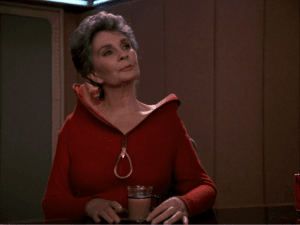 Retired Admiral Norah Satie comes aboard the Enterprise to assist in their investigation. As Satie reviews the evidence, we learn that sabotage is suspected in part because the component of the warp core that failed was included in the schematics J’Dan stole. Additionally, there is no evidence of a malfunction. Worf interrupts Picard’s meeting with Satie to report that he has discovered how J’Dan was able to smuggle information off the ship. Using a modified hypospray, he was able to encode digital information as inert proteins which were then injected into an individual’s bloodstream, meaning that someone could be carrying sensitive information without even realizing it. Satie, asks Worf to be present when J’Dan is confronted with this information. The interrogation ends with J’Dan confessing to stealing the files but not to the sabotage. Satie’a aide, Sabin – a Betazoid – believes that J’Dan is telling the truth leading the two (along with Picard) to suspect that J’Dan was not working alone.
Retired Admiral Norah Satie comes aboard the Enterprise to assist in their investigation. As Satie reviews the evidence, we learn that sabotage is suspected in part because the component of the warp core that failed was included in the schematics J’Dan stole. Additionally, there is no evidence of a malfunction. Worf interrupts Picard’s meeting with Satie to report that he has discovered how J’Dan was able to smuggle information off the ship. Using a modified hypospray, he was able to encode digital information as inert proteins which were then injected into an individual’s bloodstream, meaning that someone could be carrying sensitive information without even realizing it. Satie, asks Worf to be present when J’Dan is confronted with this information. The interrogation ends with J’Dan confessing to stealing the files but not to the sabotage. Satie’a aide, Sabin – a Betazoid – believes that J’Dan is telling the truth leading the two (along with Picard) to suspect that J’Dan was not working alone.
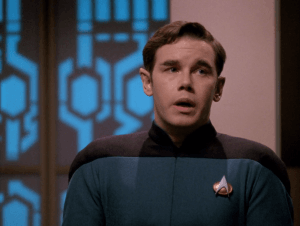
In their search for J’Dan’s collaborators, Satie, Sabin, Worf and Picard begin their investigation, questioning everyone from senior staff to junior officers. Among them is Simon Tarses, a young medical technician who happened to administer J’Dan’s injections in sickbay – the same injections he used to cover his information smuggling. Tarses, though visibly nervous, explains that he had little contact with J’Dan, administering a handful of injections and having only spotted him outside of sickbay as part of a group in Ten Forward. After his dismissal, Sabin tells the others that he sensed deception from Tarses. A lie so massive and overwhelmeing as to terrify the man. He concludes that Tarses is the collaborator.
Picard refuses to take action against Tarses on the basis of intuition, Betazoid or otherwise. Satie rebuts that he is simply giving a saboteur the chance to strike again. The argument is interrupted by a call from LaForge, who has concluded that the damage to the warp core was not intentional, but rather a coincidence brought on by a defective component. Picard is satisfied with that, though Sabin is not. Satie counters that the lack of sabotage does not indicate the lack of conspiracy. After all, one spy has already confessed. And that spy must’ve had confederates in order get aboard the Enterprise undetected. Worf and Sabin set out to investigate Tarses so that they may “establish his innocence,” though Picard reminds them that he is innocent until proven guilty. And so he is brought in for further interrogation, this time with Riker acting as Tarses’ counsel. Picard is prepared to call an end to the hearing when Sabin presses Tarses about his heritage (mostly human with a Vulcan grandfather, per Tarses), accusing him of lying on his Starfleet application, and declaring that Tarses grandfather was in fact Romulan. On Riker’s advice, Tarses takes the Fifth.

Worf instructs his security team to investigate Tarses’ background, his movements, even his school friends. Picard confronts him about this, realizing that Satie is engaging in a witch hunt. He then speaks with Tarses, and satisfied that he is speaking with a young man whose greatest hope was to join Starfleet and travel the stars, whose only misdeed was lying about his ancestry on an application, demands that Satie bring an end to her hearings, threatening to go over her head to Starfleet Command if necessary. Satie reveals that not only has she been in constant contact with Starfleet, but the scope the hearings will be broadened to include everyone on board if necessary. Further, Admiral Henry is on his way to observe the hearings. Picard vows to fight Satie’s “unethical and immoral” crusade. Later, one of Satie’s aides approached Picard on the bridge. He is to report for questioning the next morning.
During the inquisition, Satie focuses her efforts on impugning Picard’s judgment, citing past occasions when the Enterprise has been caught up in Romulans intrigue, and even his assimilation by the Borg. Picard responds simply by quoting Satie’s father, a noted Federation jurist: “With the first link the chain is forged. The first the first speech censured, the first thought forbidden, the first freedom denied chains us all irrevocably.” At this, Satie snaps, accusing Picard of treason, vowing to expose him and bring him down. As she rants, Admiral Henry stands up and walks out of the room. Satie regains her composure and calls a recess, but it’s clear to all present that it’s over. Later, Worf finds Picard in the observation lounge. The hearings are officially at an end, thanks to Admiral Henry. Picard muses on how the ever-present danger of those – like Satie – who flourish by spreading fear in the name of righteousness. Worf is unnerved at how easily he fell under her sway, and Picard reminds the lieutenant that vigilance is the price of freedom.
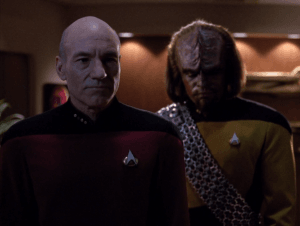 While I like ‘The Drumhead’, it’s an episode that succeeds more on the strength of its performances than its script. Indeed, as unfortunately relevant as the subject matter is (more so now than when the episode was written), Taylor’s script has a tendency to err on the side of heavy handedness. You can see this particularly in the final scene between Worf and Picard, but also in its handling of Satie. While some efforts are made to paint Satie as a reasonable person erring on the side of caution, that mostly evaporates by the end of the second act. From there on, she’s given an increasingly arch portrayal, culminating in her eruption at Picard’s hearing.
While I like ‘The Drumhead’, it’s an episode that succeeds more on the strength of its performances than its script. Indeed, as unfortunately relevant as the subject matter is (more so now than when the episode was written), Taylor’s script has a tendency to err on the side of heavy handedness. You can see this particularly in the final scene between Worf and Picard, but also in its handling of Satie. While some efforts are made to paint Satie as a reasonable person erring on the side of caution, that mostly evaporates by the end of the second act. From there on, she’s given an increasingly arch portrayal, culminating in her eruption at Picard’s hearing.
But as I said, it’s an actor’s episode. As arch as the character gets, Jean Simmons is in fine form as Satie, and Patrick Stewart is, well, Patrick Stewart. This is a lower budget, dialog-heavy episode, and that’s just the sort of show that Stewart tends to shine in. You just couldn’t ask for a better guy to read some of these speeches. Likewise, Michael Dorn has a strong turn in ‘The Drumhead’. Worf, presumably feeling he has something to prove given the tangential involvement of the Romulans, with whom his own father has been (falsely) convicted of colluding. And Worf takes to this witch hunt like a fish to water, it must be said, much to his subsequent chagrin.
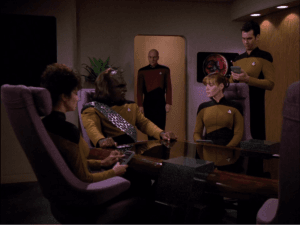
Additionally, the episode features an element with which ‘Trek’ producers had clearly been fascinated for some time: the Vulcan (or quarter Vulcan, as the case may be) crewman whose ancestry in fact, includes Romulan blood. This was a backstory element proposed for Saavik in the eighties and which would later be considered for T’Pol. Though it never made it into those characters’ canonical histories, we see if explored onscreen for the first (and, if memory serves, only) time to date. And very little comes of it. It’s a convenient way to cast suspicion on Tarses, but the character has a handful of scenes in this episode and is never heard from again, so it’s never really explored to its full potential.
I try to evaluate each episode I cover here on its own merits, without comparing them to other installments, especially ones that had yet to be produced at the time. Generally speaking, I feel like it’s (a) too easy to get a bit too “fanboy” by going down that road, and (b) it’s easy to say that a later episode – which had the benefit of hindsight – did it better. But in this case? ‘Deep Space Nine’ did it better with the ‘Homefront’/’Paradise Lost’ two-parter (coincidentally in its own fourth season) about five years later. Part of that is just down to what sort of show ‘Deep Space Nine’ was – one that was always better equipped to deal with these sorts of themes than ‘The Next Generation – and to the fact that the ‘DS9’ story is a two-parter, giving them more time to explore the short road from caution to paranoia. But it’s also because of how – there’s that word again – arch ‘The Drumhead’ tends to get. In short, watch ‘The Drumhead for the performances, but watch ‘Homefront’ and ‘Paradise Lost’ for the issues and overall execution.
What did you think of ‘The Drumhead’? How well does it handle its subject matter? Is there an episode that you think does it better? Let me know in the comments, and as always be sure to check back in two weeks for the next ‘Final Frontier Friday‘!
